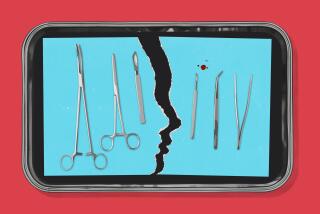Doctors answer readers’ questions about neurofibromatosis
Neurofibromatosis affects one in 3,000 people. It can appear as cafe-au-lait spots and bumps under the skin, or it can lead to complications that include blindness, scoliosis and disfigurement. The Times invited readers to submit questions to Ana Rodarte’s surgeons and two other medical experts.
Answers were provided by physicians Michael Halls, a plastic and reconstructive surgeon who helped provided Ana’s care through the nonprofit Doctors Offering Charitable Services; Tena Rosser, a pediatric neurologist, and Linda Randolph, a geneticist, both with Childrens Hospital Los Angeles.
* * *
Question: I have Moebius syndrome and am well aware that people with facial disfigurements are typically not recognized as part of the disability community even though they often experience more discrimination than those with more familiar disabilities. Physical beauty is touted over and over as being the end-all for being accepted, and plastic surgery is viewed as a path toward social acceptance. For people with facial disfigurements then, it is inferred that they are “unacceptable” without surgery. Do you find yourselves wrestling with these issues? How can you help society understand that plastic surgery is not a prerequisite for social acceptance? [Sandy Goodwick]
Randolph: Yes, we wrestle with these issues. I see many patients with birth defects and never lose sight that there is a person there with feelings and intellect. Even if the patient (in my case, mostly children) is intellectually impaired, I know their feelings are real, and I know their family cares about them as much as if they were an honor student or captain of the tennis team. My small way of helping these people is to treat them, as much as possible, as any other individual and to put them in touch with others who are experiencing similar discomfort and pain. Organizations, such as FACES: The National Cranio-Facial Assn., can help patients feel less isolated, allow them to connect with others who are going through similar experiences. If the appearance of the patient is upsetting to him or her or causing a medical problem, I refer them to a craniofacial center where a team of physicians specializing in psychology, speech pathology, plastic surgery, dentistry and genetics can address their needs. You are right: One must understand what is within the person before thinking of any type of surgery.
Halls: This is a question that deserves a larger forum on a societal level, but I would be glad to share my personal feelings. Firstly, a disfigurement in no way implies a disability. In my own world and practice, I try to treat disabilities. I try to help patients achieve a higher level of function. This can be as simple as repairing an injured hand or repairing a pressure ulcer in a paraplegic, and it can be as complex as creating a new thumb from a toe after traumatic or congenital loss. The largest part of my practice is performing breast reconstructions in women after mastectomies for cancer. This is in no way a functional restoration, as the new breast cannot produce milk and has no appreciable sensation. Many women still consider themselves disabled by mastectomy and restored after reconstruction.
As far as facial “deformities,” I always leave the question of possible surgical improvement up to the patient after supplying all of the options as well as the risks and benefits. If the patient decides to go ahead with surgery, I assume that it will help them improve their lives in some way. I personally try to accept all human appearances as part of the great bell curve that is our species.
* * *
Question: I would like to thank the doctors and all the individuals who helped Ana Rodarte. I would like to know if these tumors will come back. Will she need further surgeries? Is this disorder incurable? [Guillermina Murillo]
Halls: The surgical treatments are not meant to cure the disease but rather to correct severe deformities. The tissues that have been operated on can continue to grow. However, smaller touch-up procedures can help to prevent further major deformities from overgrowth. The progression of growth is very hard to predict and can change over time. Tumor growth does tend to slow with age.
Rosser: Plexiform neurofibromas tend to grow very slowly with time. They are very diffuse tumors that wrap around critical structures such as muscles, nerves and blood vessels. This makes them very difficult to remove completely by surgery, and since they cannot be fully removed, there is always some tumor tissue left that slowly regrows with time. It is likely that additional surgery could be done for Ana in the future if her tumor grew again, but there is no definitive cure for this condition.
***
Question: Is there any medication or procedure that, if done early in childhood, could have prevented the growth of the tumors? Doctors involved performed a miracle. [Alfonso Chavez]
Halls: So far there are no effective medications. I believe that early surgery could possibly have helped prevent severe deformities such as Ana’s, but the surgery cannot usually remove all of the involved tissues, and growth will continue.
Rosser: Plexiform neurofibromas occur in approximately 30% of individuals with NF1. They may occur in any location on the body, external or internal. They tend to grow very slowly with time. There are no definitive medical treatments to stop or slow the growth of plexiforms. However, researchers are currently using multiple drugs in NF1 clinical trials in an attempt to find a medication which might help. Surgery is the usual treatment when plexiforms become large, disfiguring or compress vital organs. Even after surgery, they tend to regrow, so in Ana’s case, performing surgery earlier would not have been likely to change her outcome.
***
Question: With so much discussion regarding stem cell research, how feasible is it that genetic disorders, such as NF, will be turned off through gene manipulation? [Jose Gutierrez]
Randolph: The protein produced by the NF1 gene is called neurofibromin. The functions of neurofibromin are not fully known, but it appears to work primarily as a tumor suppressor (when functioning normally). Mutations in the NF1 gene, or entire deletions of the gene, reduce or eliminate the function of neurofibromin, so mutations are known as “loss-of-function” mutations. Consequently, we need to think of the treatment goal as turning neurofibromin on, not turning it off.
Studies of human embryonic stem cells are giving us information about the events that occur during human development. A primary goal of this work is to identify how undifferentiated stem cells become the differentiated cells that form the tissues and organs. Turning genes on and off is key to this process. Some of the most serious medical conditions, such as cancer and birth defects, are due to abnormal cell division and differentiation. NF1 is another example of such a condition. A more complete understanding of the genetic and molecular controls of these processes might provide information about how such diseases arise and suggest new strategies for therapy.
Before we can control cell growth and differentiation, we need to know more about the signals that regulate cell division and specialization. More techniques need to be developed to introduce these signals safely into the cells and control the processes that are induced by them. Potential is there, but the reality is still in the future.
Human stem cells could also be used to test new drugs for neurofibromatosis. For example, new medications could be tested for safety on differentiated cells generated from stem cell lines. Cancer cell lines, for example, are used to screen potential anti-tumor drugs.
However, to screen drugs effectively, the conditions must be identical when comparing different drugs. Therefore, scientists will have to be able to precisely control the differentiation of stem cells into the specific cell types on which drugs will be tested -- such as a neurofibroma cell, for example. Current knowledge of this process falls short of the ability to test drugs in this way for neurofibromatosis.
***
Question: My friend’s 13-year-old daughter has one internal vascular neurofibroma plexiform tumor extending from her kidneys into her neck and into every one of her organs. She has been on thalidomide, and the tumor hasn’t progressed in her two years of puberty. Do you think you could help her? [Susan Lindner]
Rosser: Thalidomide is an anti-inflammatory and anti-angiogenesis drug (it inhibits a tumor’s blood vessel growth). It has been used to treat a wide variety of medical conditions. A small study evaluating the safety and efficacy of thalidomide for use in 20 individuals with NF1 and symptomatic plexiform neurofibromas was published in 2003. Some reduction in tumor size was seen in four patients. Drugs that work by other mechanisms are also being tried in current NF1 clinical trials. A list of open clinical trials can be found on the Children’s Tumor Foundation website.
More to Read
Start your day right
Sign up for Essential California for news, features and recommendations from the L.A. Times and beyond in your inbox six days a week.
You may occasionally receive promotional content from the Los Angeles Times.






